Last updated on 4/7/24
View My Guestbook
Sign My Guestbook

Last updated on 4/7/24
Site established on 3/22/01
|
|
Weapons
|
Click here to read Doug Kibbey's article on the fougasse defense device |
||
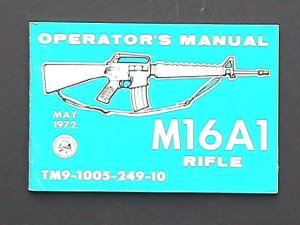
M-16 manual |
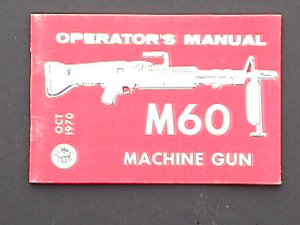
M-60 manual |
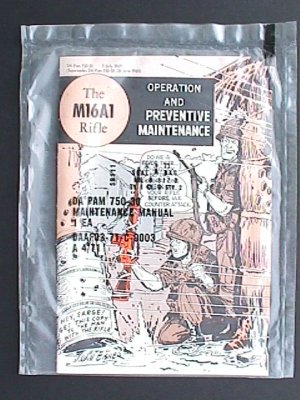
Water tight sealed - cartoon illustrated M-16 manual |
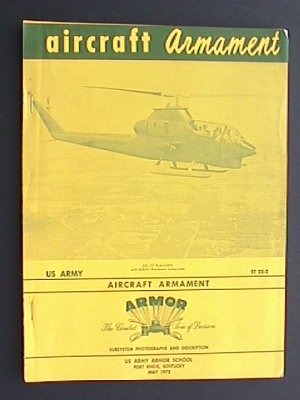
Armor school instructional manual on Aircraft Armament |

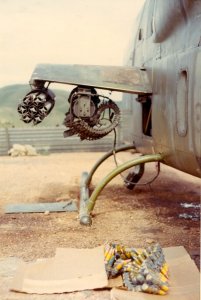
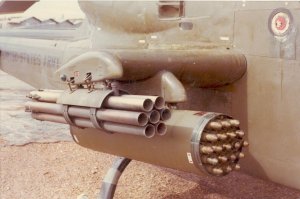
AH-1G of A or B Trp.,2/17th Cav. Camp Eagle view of 20mm with ammo in foreground & loaded 7 shot 2.75" FFAR tubes.- 1971 Image courtesy of Doug Kibbey |
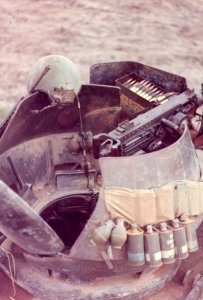
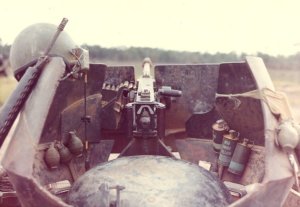
M113 ACAV Cmdr. cupola with M2 .50cal HB, M16A1, and assorted fragmentation & smoke grenades. Vehicle HQ-71, "G"trp, 2/11th ACR. This was my "office" in Hau Nghia province, early 1972. Note close proximity of critical Headspacing Feeler & Go/No-Go Gauge for the .50cal. just under frags on right side of cupola. Image courtesy of Doug Kibbey |
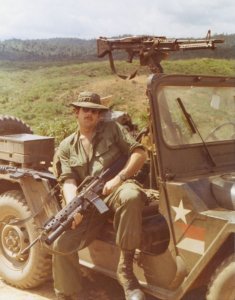
XM-148 (M16A1 with M203 40mm grenade launcher) and M60 on gun jeep. "D" Trp, 2/17th Air Cav. FireBase Birmingham, Thua Thien province - 1971. This is the same mission as the mortar pics were taken on Image courtesy of Doug Kibbey |
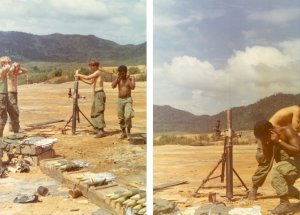
Why mortars on an Air Cav site? This is "D" trp.,2/17th Air Cav mortar section at work at FireBase Birmingham in Thua Thien province 1971. As RTO, I was frequently called upon to act as FO and correct fire for the 11C's. The green streak from the tube in 2nd frame is not an artifact, but the image trace of an 81mm round emerging from the tube. On a clear day at closer ranges, you can observe the round through it's entire flight against a bright background, such as the sky. Image courtesy of Doug Kibbey |
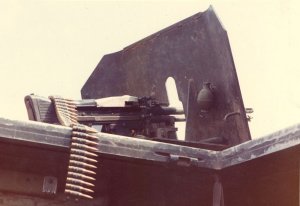
One of 2 M60 positions on my M113 ACAV, HQ-71. Still with "G" Trp., 2/11th ACR, Hau Nghia province - 1972 Image courtesy of Doug Kibbey |
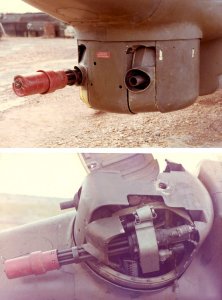
AH-1G nose turrets with 'muzzled' 7.62 miniguns & 40mm "Thumper". The upper one is 2/17th Cav. and the upside down one is Jimmie Ferguson's A/4/77th ARA AH-1G #67-15690 after the shoot-down, viewable elsewhere on this website. Image courtesy of Doug Kibbey |
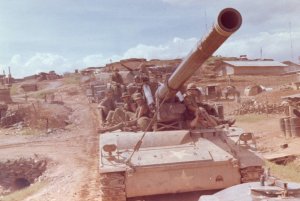
Self-propelled 175mm in transit, security escort courtesy of "D"trp.,2/17th Air Cav. Thua Thien province - 1971. Image courtesy of Doug Kibbey |
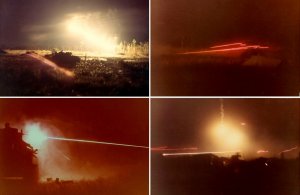
A composite of 4 images taken during a night action at an NDP in Hau Nghia province involving "G"trp.,2/11th ACR in 1972. Images show flare illumination of tree line, engagement with .50cal from an M551 Sheridan, followed by everything we had on that side of the NDP." This is the action that resulted in the scouting by the Air Cav troop the next AM previously sent and posted for 2/11th ACR. Image courtesy of Doug Kibbey |
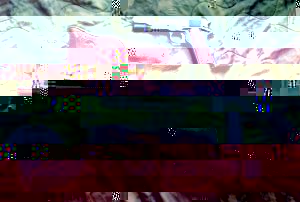
The ultimate in load simplification, .45 ACP only! Mark IV, Series '70 (a gift from my father just before departing for RVN) & M1928-A1 (local acqusition from CCN "no-name")...hated parting with that last item! Image courtesy of Doug Kibbey |
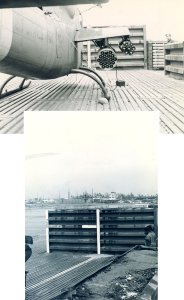
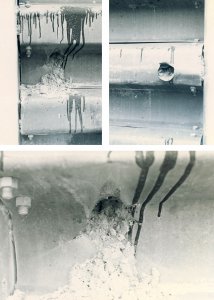
One day at Phu Bai, we heard the hiss of a rocket and an explosion, which we took to be incoming. Worse than that, two 45J's (aircraft armorers) lost their lives when they were testing the weapon system of this AH-1G belonging to C Trp., 2/17th Air Cav. and a rocket discharged, penetrating both of them, the revetment, and finally crossing the airfield to explode in the PA&E yard (Pacific Architects & Engineers). I took a about 2 dozen pictures of the set-up for the investigation, of which these are a few (just happened to be around & had a good camera with me at the time). Not being a 45J myself, I can only guess the cause to be an inadequate ground on the test equipment, judging by the emphasis placed on getting pics of the switch settings and the alligator clips on a protrusion from the aircraft. In the sequence you can see how far the rocket dropped before penetrating the revetment, the entrance and exit from the revetment (note impressions left by the fins) and the location of the Phu Bai Airport Terminal beyond. Note to the morbidly inclined...that's tar on the revetment. Image courtesy of Doug Kibbey |
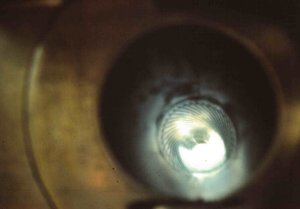
Looking up the barrel of a 105 howitzer. Operation Clean Sweep 12/65 Image courtesy of Ed Lemp |
|
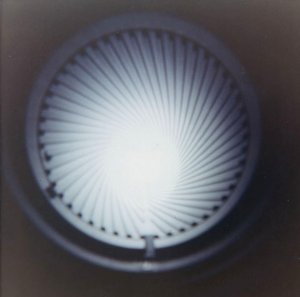
View down the tube of a 152mm Gun/Launcher of an M551 Sheridan. Look closely and you will see the keyway that the Shillalagh missile would track down, since spinning would disrupt guidance. M551's in Vietnam service had the gun, but weren't equipped with missile guidance gear as it wasn't useful there. The transmitter box over the gun tube was usually either used for tools, or as a 'stash box'. Image courtesy of Doug Kibbey, Cmdr., HQ71, M113 A CAV, "G"Trp., 2/11 ACR |
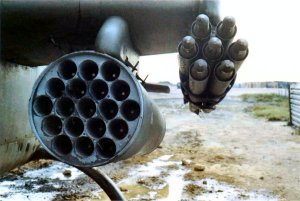
Rocket Pod on Cobra Image courtesy of Carl Trapp via Randy White |
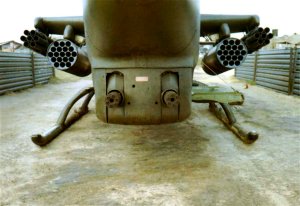
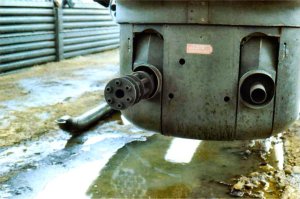
Business End of the Cobra. Image courtesy of Carl Trapp via Randy White |
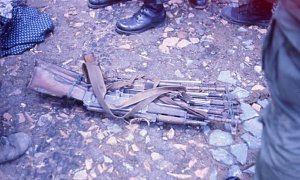
These (AK-47s) where captured about the 5th day of tet near the 3 sisters area near the border Image courtesy of Lowell L. Eneix |

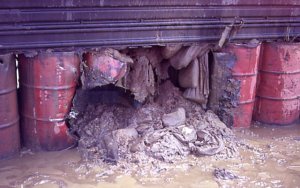
I disconnected the battery Sir!!! Spoken by sp4 electrician. We had a problem with the selector. So the sp4 was trouble shooting with a ohm meter. The ohm meter had a couple of batteries. All it took was 2 and a half volts to set off the rocket. After the explosion Jerry Daly walked up, looked at the ship. Got the sp4's explanation and said "think we should adjust the bore sight?" then walked away. From then on we did ohm checks on mt pods. Was a funny. After we knew no one was hurt. This was at the Viking line at Soc Trang around April. Or sometime just after 68 tet. I was not involved. Just knew the maintenance crew was trying to fix the selector. As far as I know nothing was ever written up about this incident. Image courtesy of Lowell L. Eneix |
|
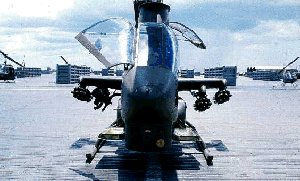
Snake with Fangs - A 2/17 Cav bird Image courtesy of Jim Newman |
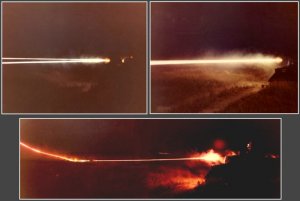
"Night fire from the NDP" images courtesy "G" Trp., 2/11th ACR in Hau Nghia province - '72 Image courtesy of Doug Kibbey |
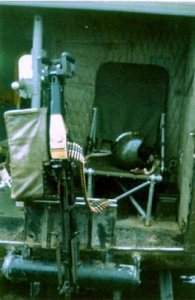
Slick gun Image courtesy of Forrest L. Webb |
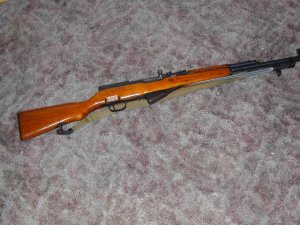
SKS rifle taken during Tet 68 at Moc Hoa. This SKS was part of a cache of 51 weapons our A Team captured during the 68 TET Offensive. This particular rifle was buried in the mud in a rice paddy. Markings on the rifle indicate that it was manufactured in Czechoslovakia. Click here to read how Judd got this rifle home Image courtesy of Judd Clemens |
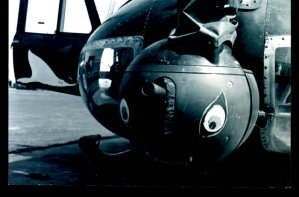
40MM ball turret on C model Huey of the 9th Avn. Co. Note edge of "Stingray" unit logo on door. Image courtesy of Bill Brooks |
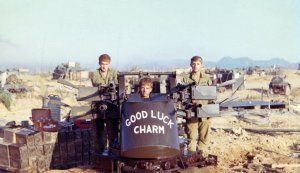
This pic is from FSB Currahee, in the A Shau Valley, summer '69, Operation Montgomery Rendezvous, which was the continuation of Apache Snow which encompassed the north end of the valley. MR included the whole of the A Shau Valley, it lasted longer and was more productive than Apache Snow, but didn't get the same press. It was a tough fight all over the valley but in the end Chuck couldn't take the beating and withdrew. We weren't aware of the controversy Stateside and were very proud to have taken part in such an epic battle. Our guns spent 5mo. on the valley floor at Currahee and we were the very last of the 101st to leave. Image courtesy of Raz Reed |
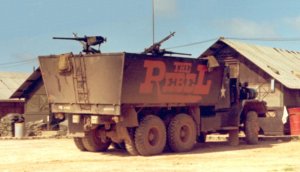
"The Rebel"...formerly "The Assassin"...the only gun truck in 'Nam with this unique 'downward sloping' armor applied to a 5-ton cargo. Used for convoy escort, in this case with 57th TC, the 'Nam Nomads, I believe. I caught it here at Phu Bai in late '71 Image courtesy of Doug Kibbey |
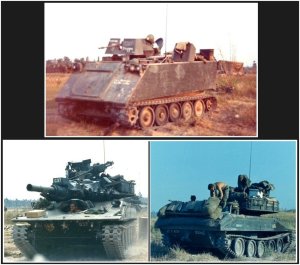
Principal vehicles of Light Armored Cavalry (traded M-48's for THESE?), M113 ACAV (G-71,top) & M551 Sheridans (G-37 & G-39,bottom). Click here to read more Image courtesy of Doug Kibbey |
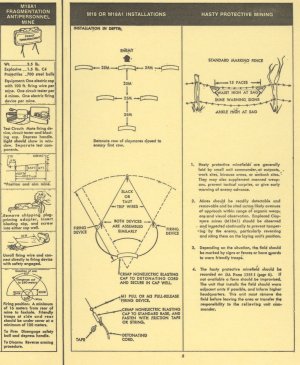
M18/M18A1 (Claymore) mine installation, from pages 4&5 of GTA 5-10-10 Mine Card-June, 1970 Image courtesy of Doug Kibbey |
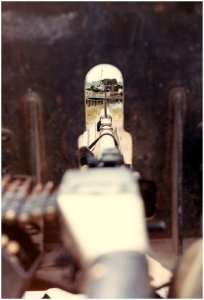
View down the M60 MG of an M113 ACAV...(no, there was no round chambered!) 'G' Trp, 2/11th ACR in Hau Nghia province NDP, '72 Image courtesy of Doug Kibbey |
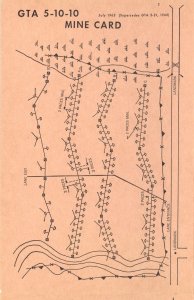
GTA 5-10-10 Mine Card, complete. Rev. 1965 Click here for image 2 Click here for image 3 Click here for image 4 Click here for image 5 Click here for image 6 Click here for image 7 Click here for image 8 Image courtesy of Doug Kibbey |
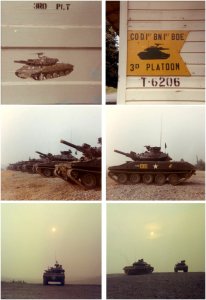
11th ACR members (and anyone else who was M551 qualified) almost certainly spent some time at this place...'Sheridan School', D-1-1 at Ft. Knox...just down the street from the NCO Academy, though not necessarily 3rd platoon (I was assigned platoon leader there after a shake-&-bake leadership course at the Academy). We got our assignments standing in formation after graduation from here by standing in formation and having our names shouted out followed by either "Germany" or "Vietnam"...I was in the latter group...like about half my class. The firing line pictures look like the Cedar Creek Range." Image courtesy of Doug Kibbey |
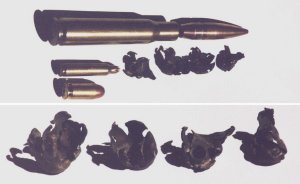
Terminal ballistic effects on four M16 5.56mm rounds, shown close up at bottom, and again with a .50cal, .45ACP and a 5.56mm M16 blank cartridge at top for scale Image courtesy of Doug Kibbey |
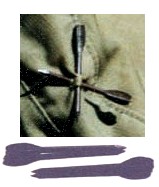
Fléchettes - French for 'darts', though we just called them 'nails'. Anti-personnel projectile (about 1.5 inches long) found in many types of ordnance...these are from 152mm 'canister' round on an M551 Sheridan...about 5000 per round, if I recall correctly. Basically a giant shotgun, this is what we routinely kept chambered in the Sheridans and it paid to stay beside or behind them when assaulting in-line Image courtesy of Doug Kibbey |
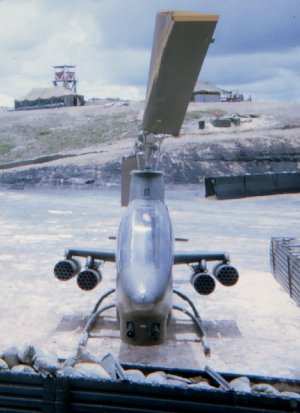
The business end of "No Slack" taken in September 1969 at the B /2/17th Banshee pad on Camp Eagle. A/C number was 68-15703... In the fall of 1969 B troop had a policy of assigning an aircraft to each aircraft commander for them to generally fly (operational conditions permitting) and, in the case of the Cobra platoon, arm the way they wanted... The normal configuration for B troop Cobras was to carry a minigun and 40mm grenade launcher in the turret and a set of 7 shot rocket pods on the outboard wing points and 19 shot rocket pods on the inboard points... I instead chose to carry 19 shot pods on all four wing points... Other pilots did not like to fly my a/c (703) because they believed I had overstressed it by carrying 76 rockets without cutting back on fuel and not modifying the high-g maneuvers... This did not bother me, because I didn't particularly wanting them flying my Cobra on my days off, anyway ..... The 76 rocket configuration was the same as used by Aerial Rocket Artillary Cobras, but they flew the aircraft differently due to their different mission than the Air Cav did and thus did not put the strain on the aircraft that I tended to do... Image courtesy of Bill Russell B/2/17th Air Cav, 101st Abn Div 1969, 334th Atk Hel Co, 1st Avn Bde 1970 |
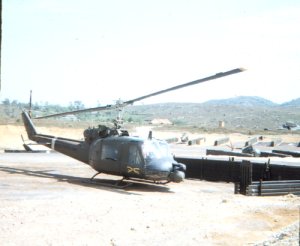
One of our UH-1B Command & Control aircraft that was flown by the air mission commander (usually the C.O.).... Notice the 40mm grenade launcher in the nose... This would have been taken in April 1969... Soon after, the grenade launcher was removed as being unnecessary for a high flying C&C ship and then later our two UH-1B's were replaced with UH-1C's for added speed... Image courtesy of Bill Russell B/2/17th Air Cav, 101st Abn Div 1969, 334th Atk Hel Co, 1st Avn Bde 1970 |
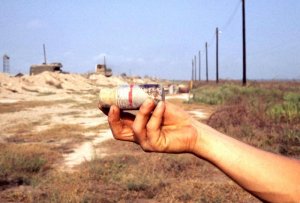
Chunker CS Round Image courtesy of Robert Geiger |
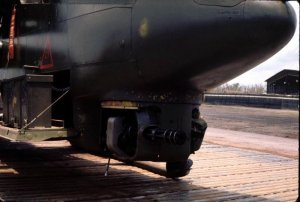
Turret on AC 060 Mini Gun & Feeder Delinker Image courtesy of Robert Geiger |
|
One of the many private purchase knives of the time that were carried by Pilot's and crew who were'nt too impressed with G.I. issue examples. This example of a Buck hunting knife was presented as a gift in 1967. It remains mint - in original carton with accessories |

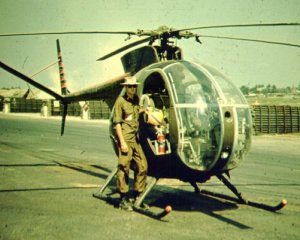
Aero Scout tools of the trade brought home by Don Callison (Warwagon 14). The butt of this .357 pistol can clearly be seen on Don's hip in the photo to the right.
Image courtesy of Don Callison "Chicken Little" |
|
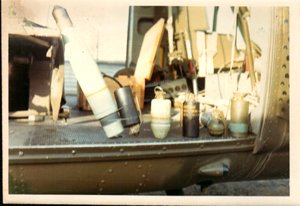
Some of the different types of standard and improvised grenades we used, C 7/1 Image courtesy of Al Sever, Crew Chief |
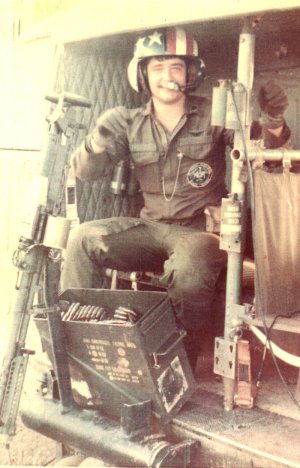
Bill Blackburn of C Co., 227th CAB in the "Office". Clear example of the popular application of a C ration can for am M-60 feed ramp. Note also tactical placement of smoke grenades Image courtesy of Bill Blackburn via Joe Stone |

Cobra Rocket Pod after the close of another business day! Image courtesy of Jan Null |

Image courtesy of Jan Null |
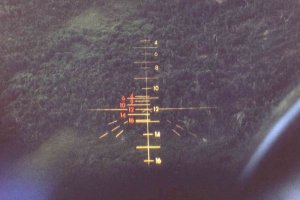
Looking thru the reflex sight in the front seat of a Cobra. Sight is for the turret weapons. Image courtesy of Chip Decker of the 128th AHC |
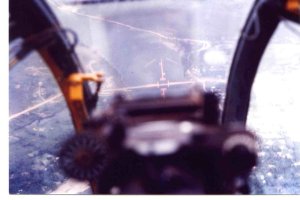
In dive on bridge up north, simulating ARA. Looking thru wingstores sight, back seat of a Cobra. Image courtesy of Chip Decker of the 128th AHC |
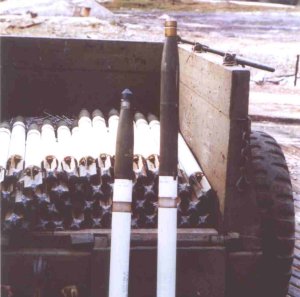
The two type of high explosive rockets small is 10 lb warhead, large is 17 lb warhead Image courtesy of Chip Decker of the 128th AHC |
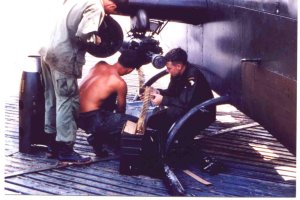
Wo1 Mike Chase helping load the M18E1 wing minnigun pods Image courtesy of Chip Decker of the 128th AHC |
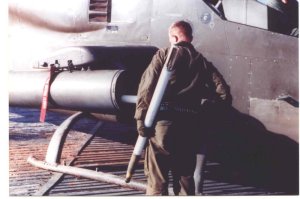
Lt 'Toasty' Smith loading rockets. Can't remember Toastys real first name but he got the one we remember him with by laying/sleeping on the wing one nice day while waiting for a mission, got sun burned and started to peel all in one hour Image courtesy of Chip Decker of the 128th AHC |
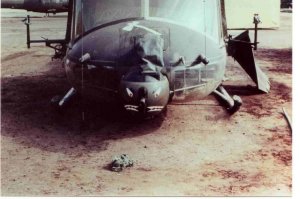
One of the Gunslingers 40 mm grenade launcher birds. These aircraft normally had 19 shot rocket launchers also. Image courtesy of Chip Decker of the 128th AHC |
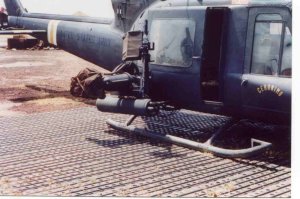
Gunslinger bird named Geronimo. This aircraft was armed with the M16 subsystem, four M60 flex guns, 2 on each side and a 7 shot rocket launcher on each side. The barrels have been pulled and the receivers covered to keep the red dirt out of the guns. The aircraft carried 6000 rounds of 7.62 mm ammunition for the 4 M60s. Image courtesy of Chip Decker of the 128th AHC |
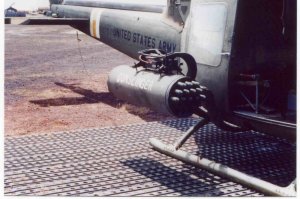
The 19 shot rocket launcher set-up for one of the aircraft with the 40 mm grenade launchers. Image courtesy of Chip Decker of the 128th AHC |
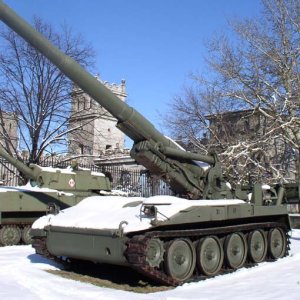
I woke up today and my first thought was : "Hey, isn't there an M-107 standing in front of the Polish Army Museum ?". So I took my camera and I went there. Having taken the photos I asked the staff about the history of this particular M-107. It was left in Vietnam ( they couldn't give me the exact location ) and then, after the war, it was taken to Poland. In Poland it was transported to the "W.A.T." in Warsaw. The "W.A.T." is a military academy that specializes in technology. The engineers of the Academy were supposed to disassemble the M-107 and then put it back together again. Having done that they were supposed to design a similar weapon. The M-107 stayed at the "W.A.T." for a long time. Eventually it was given to the Polish Army Museum and it still resides there. I have also heard that the "W.A.T." still has an F-4 Phatnom somewhere. Getting to it might be difficult, but I think I'll give it a try some day. Image courtesy of Krzysiek Walczak |
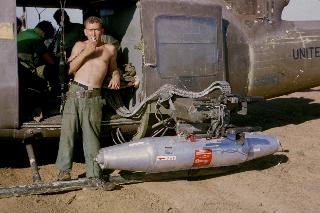
There's not too many people will believe this! That is a 250 Lb napalm can. We carried two of them and they worked great. That was one of my "inventions". They held about 29 gal of gas and the jelly stuff. We droped them individually by pulling a piece of commo wire attached to the emergency lever on the bomb shakle. It was really tough on a village. We used this several times on the north end of happy valley. I think it slowed there actively shooting at us every time we flew by. Image courtesy of John Ghere B 1/9 |
|
|
Here is a shot of 65-00001 a H model Circa 69-70 from the 11th CAB, with a NightHawk system consisting of a door mounted mini, a Night Observation Device(NOD) and a Xenon searchlight with in fared capabilities.UI believe there were 14 systems in-country. Some also had a door mounted 50 caliber. The concept behind the system was to fly blacked-out, low and slow to identify infiltration routes. Once identified by NOD,we would light them up with the Xenon and engage with the mini or call in a gun team. We were also used for night extractions and in a fire support role for night ambush operations. Image courtesy of Hal Marsolais, 11 CAB, 1969-70 |
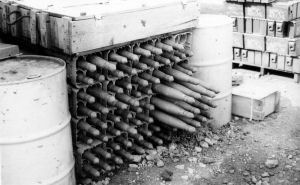
Rockets in storage bunker. It is very easy to distinguish the 10 lbs. from the 17 lbs. warheads. All of these rockets are point detonated high explosive rockets. As the UH-1B/C gunships had a crew chief and a gunner to protect the tail, the helicopters flew at very low levels or NOE (Nap of Earth). The rockets with a proximity fuse for detonation were not effective at these altitudes as they would detonate as soon as they armed unless the helicopter would "pop up" to shoot at a higher angle. Image courtesy of George Quackenbush |
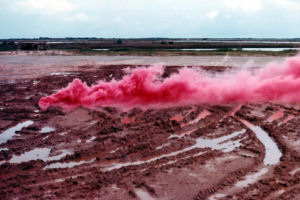
While technically not a weapon the smoke Grenade was used for marking targets, friendly positions, enemy positions, tossed when enemy fire was received, landing fields, guide for bombing attack and for wind speed and direction. They came in different colors including white, green, purple and red. During a typical day, a Viking Gunship would use 15-25. During the Monsoon season in the Delta, the smoke grenades would need to be popped then held for sever seconds to allow them to get burning well before tossing or else they would go out on hitting the water covering the fields. The other solution was to cut a hole in the cardboard can that they came in, unscrew the firing device and put the smoke back in the can with the firing device outside of the can. This allowed the smoke a few seconds to get lit before being covered with water. Image courtesy of George Quackenbush |
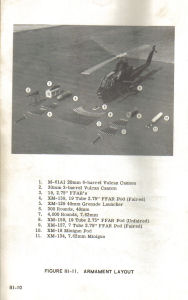
Armament layout from orientation manual. Image courtesy of Charlie Eaves |
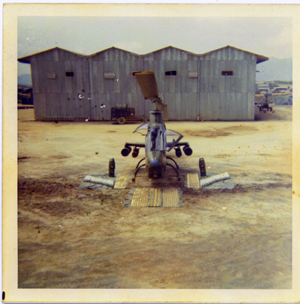
1970 armament display of a D-158-101st Abn Div AH-1G cobra In the distant background, on the right hand side of the hanger are the hootches of C/4/77, which were at the western end of the Camp Evans airfield. Image courtesy of Tom Kehoe |
|
All images remain the personal property of this site and the contributor of the photo. You may download them for your personal use but they may not be published or used on any other site without written permission from the webmaster and the contributor.